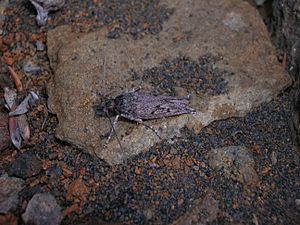Thyrocopa facts for kids
Quick facts for kids Thyrocopa |
|
|---|---|
 |
|
| Grasshopper moth (Thyrocopa apatela) Haleakala National Park, Maui, Hawaii |
|
| Scientific classification | |
| Kingdom: | |
| Phylum: | |
| Class: | |
| Order: | |
| Family: |
Xyloryctidae
|
| Genus: |
Thyrocopa
Meyrick 1883
|
| Species | |
|
|
|
| Synonyms | |
|
|
Thyrocopa is a special group of moths. You can only find them in Hawaii. There are about forty different kinds, or species, of Thyrocopa moths. Some of these moths are very unique because they cannot fly!
Contents
Amazing Adult Moths
Most moths can fly, but some Thyrocopa moths are different. They have tiny wings and cannot fly at all. This is called brachyptery. It's very rare for both male and female moths to be flightless.
Why Some Moths Can't Fly
Scientists think these moths lost their ability to fly over time. This happened because of their environment. Places with strong winds, few predators, or scattered food might make flying less useful. It's like how a fish living in a dark cave might lose its eyesight.
Scientists studied two flightless Thyrocopa species. They found that each species lost its flight ability on its own. This is called convergent evolution. It means different species developed the same trait independently. This happened in less than a million years!
Life Cycle and Larvae
Like all moths, Thyrocopa moths start as tiny larvae (caterpillars). These larvae are mostly "generalist" eaters. This means they can eat many different things. They often eat decaying leaf parts. They also build little web-like homes from their waste, called frass.
What Thyrocopa Larvae Eat
One special kind of Thyrocopa larva is a "specialist." It only eats the inside of a plant called Broussaisia arguta. This plant is a relative of the hydrangea and grows only in Hawaii.
In labs, these larvae can stay caterpillars for 2 to 20 weeks. Then they turn into a pupa (like a cocoon) for 2 to 8 weeks. After that, they become adult moths.
Thyrocopa larvae have been found on many different plants. Most of these plants are native to Hawaii. Some examples include:
- maile (Alyxia oliviformis)
- paʻiniu (Astelia argyrocoma)
- ʻākōlea (Athyrium microphyllum)
- lapalapa (Cheirodendron platyphyllum)
- pilo (Coprosma elliptica)
- ʻōhiʻa lehua (Metrosideros polymorpha)
- pūkiawe (Styphelia tameiameiae)
Different Kinds of Thyrocopa Moths
There are many different species in the Thyrocopa group. Here are some of them:
- T. abusa
- T. acetosa
- T. albonubila
- T. alterna
- T. apatela (also known as the grasshopper moth or Haleakala flightless moth)
- T. apikia
- T. brevipalpis
- T. cinerella
- T. decipiens
- T. elikapekae
- T. epicapna
- T. geminipuncta
- T. gigas
- T. indecora
- T. kanaloa
- T. kea
- T. keliae
- T. kikaelekea (a recently discovered species)
- T. kokeensis
- T. leonina
- T. megas
- T. minor
- T. neckerensis
- T. nihoa
- T. peleana
- T. sapindiela (also known as the Oahu aulu thyrocopa moth)
- T. seminatella
- T. spilobathra
- T. subahenea
- T. usitata
- T. vagans
- T. viduella

